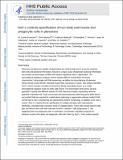foxF-1 Controls Specification of Non-body Wall Muscle and Phagocytic Cells in Planarians
Author(s)
Scimone, M. Lucila; Wurtzel, Omri; Malecek, Kathryn; Fincher, Christopher T.; Oderberg, Isaac M.; Kravarik, Kellie M.; Reddien, Peter W.; ... Show more Show less
DownloadAccepted version (4.817Mb)
Terms of use
Metadata
Show full item recordAbstract
Planarians are flatworms capable of regenerating any missing body part in a process requiring stem cells and positional information. Muscle is a major source of planarian positional information and consists of several types of fibers with distinct regulatory roles in regeneration. The transcriptional regulatory programs used to specify different muscle fibers are poorly characterized. Using single-cell RNA sequencing, we define the transcriptomes of planarian dorsal-ventral muscle (DVM), intestinal muscle (IM), and pharynx muscle. This analysis identifies foxF-1, which encodes a broadly conserved Fox-family transcription factor, as a master transcriptional regulator of all non-body wall muscle. The transcription factors encoded by nk4 and gata4/5/6-2 specify two different subsets of DVM, lateral and medial, respectively, whereas gata4/5/6-3 specifies IM. These muscle types all express planarian patterning genes. Both lateral and medial DVM are required for medial-lateral patterning in regeneration, whereas medial DVM and IM have a role in maintaining and regenerating intestine morphology. In addition to the role in muscle, foxF-1 is required for the specification of multiple cell types with transcriptome similarities, including high expression levels of cathepsin genes. These cells include pigment cells, glia, and several other cells with unknown function. cathepsin+ cells phagocytose E. coli, suggesting these are phagocytic cells. In conclusion, we describe a regulatory program for planarian muscle cell subsets and phagocytic cells, both driven by foxF-1. FoxF proteins specify different mesoderm-derived tissues in other organisms, suggesting that FoxF regulates formation of an ancient and broadly conserved subset of mesoderm derivatives in the Bilateria.
Date issued
2018-12Department
Massachusetts Institute of Technology. Department of Biology; Whitehead Institute for Biomedical ResearchJournal
Current biology
Publisher
Elsevier BV
Citation
Scimone, M. Lucila et al. “foxF-1 Controls Specification of Non-body Wall Muscle and Phagocytic Cells in Planarians.” Current biology 28 (2018): 3787-3801.e6 © 2018 The Author(s)
Version: Author's final manuscript
ISSN
0960-9822